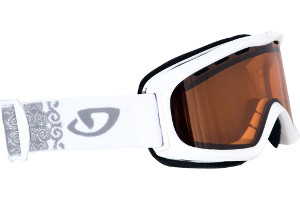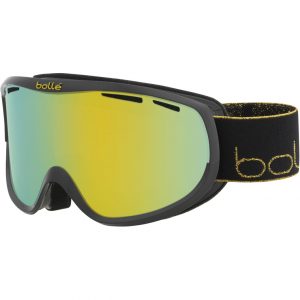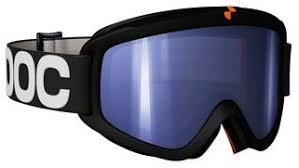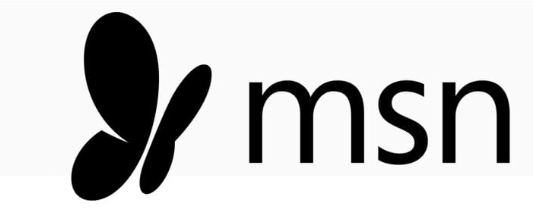You can spend $250 on ski goggles, but you don’t have to.
As a skiing novice, you don’t want to break the bank on an unnecessarily high-tech pair of goggles. A $75 (or less) set of ski or snowboard goggles will do the job very well, and we recommend 4 good options below.
Spending more on goggles may get you better anti-fog capabilities, better compatibility with your helmet, and better visibility in certain conditions. If you are just starting out, though, you just need something that will protect your eyes from the sun and wind.
To make it easier for you to decide which goggles will best suit your needs, we’ll introduce you to some of the best ski goggles that are perfect if you’re just starting off on your adventures on the slopes. All of these goggles can typically be found at prices below $75, so won’t break the bank either.
Goggle
Our Take
Check Price
Smith Frontier Goggles
Reliable all-around goggle with good anti-fogging features
Giro Cruz Goggles
Good quality for the money, maybe not ideal for bright sun.
Bolle Sierra Goggles
Nice lenses for a variety of light conditions, perhaps best for small-to-medium sized faces.
What to Look for in Beginner’s Ski Goggles
Ski and snowboard goggles should perfectly fit your face and helmet while protecting your eyes from snow, ice, and wind as well as the brightness snow and sun can produce. High-quality products are designed to be compatible with a wide range of helmets by having an adjustable strap and a suitable frame.
Most manufacturers use UV protection even on their most basic goggles. The intensity of UV radiation increases with altitude, so protecting your eyes is an extremely important consideration. UV-protected lenses will prevent both eye strain and damage to your retinas. Don’t forget to consider your typical conditions — and if you think you will routinely be skiing in flat light, that could be a situation to upgrade for. There are specific goggles that perform well in those conditions.
Besides fitting your face, the other imperative is that a ski goggle doesn’t fog up. This is a factor of a few things — if the goggle fits well to your face, how it blends with your other head gear like masks and helmets, and finally the quality of the goggle itself. A great air ventilation system and no-fog treatment are also essential, because they help to prevent fogging and moisture that comes with temperature differentials commonly encountered while skiing.
As skiing involves moving sideways, it can be nice to upgrade to a pair of goggles that allows for a peripheral view. These also have longer lenses which help you get a better view of what is around you, minimizing the risk of encountering unexpected hazards, hitting something or someone. Speaking of range-of-view, be sure you check out our piece on wearing eyeglasses with goggles if that is your plan on the slopes.
Best Beginner Ski Goggles for 2024 Ski Season
Smith Frontier Goggles
Smith has been making reliable ski goggles even since we started skiing, and they keep their prices in check so you wont’ break the bank.
For beginner skier, the Frontier goggles provide a good all-around goggle at a really nice price. They should work well with most helmets, and the field-of-vision is pretty good. You can get better, but only if you spend more money.
The build of the goggles provides pretty good anti-fog qualities, but as the goggle ages you are probably going to want to add a bit of de-fogger to the lenses. That should need to happen for a while, though.
We’ve tested these goggles while both skiing and snowboarding, and they perform well in both situations. The lenses adjust pretty well on bright sunny days, and the construction is solid. In the box, you will also get a soft case for the goggle which we recommend using anytime you are transporting or storing the goggles around other ski gear, a goggle lenses have a way of very easily getting nicked up.
Pros:
- Nice price
- Good lens for anti-fogging
Cons:
- Plastic frame can get brittle in super cold conditions
Giro Cruz Goggles
 Giro’s entry-level goggles are nice, comfortable, full-sized goggles, so they’re easily going to fit a wide variety of different sized faces. They’ve got some lovely foam ventilation that will keep them from fogging on the hill and their the injection-molded cylindrical lens creates a smooth field-of-vision with little distortion, so you’ll be able to enjoy an expansive and crisp field of view. This is particularly important for boarders, who are disadvantaged in their normal sight lines because of the positioning while boarding.
Giro’s entry-level goggles are nice, comfortable, full-sized goggles, so they’re easily going to fit a wide variety of different sized faces. They’ve got some lovely foam ventilation that will keep them from fogging on the hill and their the injection-molded cylindrical lens creates a smooth field-of-vision with little distortion, so you’ll be able to enjoy an expansive and crisp field of view. This is particularly important for boarders, who are disadvantaged in their normal sight lines because of the positioning while boarding.
Also, the persimmon tinted lens is great for pretty much any light conditions. In terms of construction quality for under $50, you can count on the Giro Cruzz Goggles for a good all-around goggle that will be comfortable on your face. Boasting double-layer face foam with micro-fleece facing, this product will offer you comfort all day long. Plus, it’s compatible with a huge variety of helmet designs.
For more advanced skiers, we also like the Cruz goggle as a spare set to keep in our ski bag, just in case you break your lose your primary set.
Pros:
- Don’t fog easily
- Quality for the money
Cons:
- Tint is not strong, so not ideal on bright sunny days
Bolle Sierra Snow Goggles
Bolle has changed its vast goggle lineup heading in to the 2022 season, and the sweet spot for a beginner goggle in our opinion is the all-purpose Sierra. Not the cheapest in Bolle’s lineup, it puts you in a position of having a quality and comfortable goggle without spending a ton of money.
These all-purpose, reasonably priced goggles feature a decent selection of different colored lenses you can choose from. Their double lens creates a thermal barrier that keeps the cold far away. Thanks to the directional airflow over the lens’ inside, the flow-tech venting system prevents fog build up, allowing you to enjoy a clear view all around and The Bolle Sierra Snow Goggles’ Carbo-Glass works as a protective shield that prevents scratches. Moreover, the double layer face foam provides you with comfort all through your day on the slopes. Overall, a good pair of ski goggles, especially for someone who wants a pair that will serve them well if they find themselves skiing more and more.
Pros:
- Lenses work with in a variety of light conditions
- Work with with most helmet brands
Cons:
- A bit smaller – perhaps not ideal for large faces
Ski Goggle FAQs
Which Ski Goggle Lens Color Should I Buy?
There are a multitude of lens colors available with goggles, which can actually make the decision kind of paralyzing. We recommend two categories of lens color: UV protection, and flat-light enhancing.
Goggles for UV protection are usually going to be colored brown or nearly black, and sometimes with a mirrored look. These will basically serve as sunglasses for those bright, sunny days. Amber goggles fall into this category too.
The goggle lenses that help create better contrast for flat light visibility are usually orange, yellow, red, and green. They will help bumps stand out a bit more, so you can precisely navigate terrain.
What do we use? We usually go for some time of yellow tint, because it tends to provide great flat-light assistance, but also usually offers good UV protection (but check the specs to be sure).
Do I need to match ski goggles to my ski helmet?
It helps, but is not imperative.
Using the same brand ski goggles and helmet often creates a nice, seamless “system”. For example, a POC helmet is typically designed to fit perfectly with a pair of POC goggles. However, a pair of Smith Goggles will probably do just fine with a POC helmet to, and vice-versa.
The small things that you might notice when combining goggles and helmets of different brands are that there may be gaps on the side of the face, or on the forehead in between the helmet and the goggles. Also, the goggles might be just a bit clumsier when trying to secured the strap in the clip on the back of the helmet. But half the mountain is going to be skiing with whatever goggles and whatever helmet the skier brought with them that day, so it is not critical to match.
Do the same goggles work for skiing and snowboarding?
Generally speaking, yes. You can pretty much use them interchangeably. Until to become super-specialized (e.g. competitive downhill ski racing, or freestyle snowboard competitions), which really only is about 5% of us, you can pretty much choose whichever goggle feels best and is in your price range. The key is to get goggles that are specific to snow sports. Occasionally, goggles for other uses like motocross can look deceivingly similar to snow goggles, but they won’t work nearly as well.
How do I keep goggles from fogging?
Newer goggles generally fog less than older ones, because their anti-fog technology has not worn out, so one way to keep your goggles from fogging is to replace them each season or two.
Make sure you let your goggles dry out between use, and try to get enough ventilation on the mountain flowing so that the air will keep your goggles from fogging. If worse comes to worse, you can buy anti-fog wipes or sprays, but this is usually a temporary solution.
Are ski goggles unisex?

Most of them are. All of the goggles we profiled above are unisex and can be used for any skier or snowboarder. About 10% (roughly) of goggles on the market are marketed as gender-specific, but we don’t review those.
What do I get for my money if I spend more on ski goggles?
The price points we reviewed above are generally in the $60 or less range. If you want to spend more, which you very easily can, you will find a goggle that offers a wider field-of-vision, may be more comfortable on your head or helmet, should have higher-quality plastic that won’t crack in cold conditions, and will be more resistant to scratching. That last point — avoiding scratching — can make the difference between using the goggles for one season or for multiple seasons. So, by spending a little more, you might find that you actually get more value.
For intermediate skiers, you may want to invest in a goggle that is higher-performance and will give you a more commanding field-of-vision and better quality. A more advanced, all-around goggle that we really like is the POC Opsin, here on Amazon. It gives you a notable step up in some of the goggles features.
Conclusion
We hope that this guide has helped you choose the ski goggles that best suit your beginner needs. As a rule of thumb, always go for a trustworthy brand and don’t opt for an expensive product if you don’t need one. Most goggles for novices are packed with superb specs that will keep you safe and offer you an amazing experience on the slopes. Last but not least, make sure that the item you want to purchase will provide you clear optics, comfort, and flexibility.
Check out our ski gear checklist for a roundup of the other gear you will want to be sure you have for those first few times on the slopes. Also, don’t fret about buying skis — most resorts now offer good rental options. Keep your money focused on the gear that will keep you safe (helmet, goggles) and comfortable ( jackets, pants, gloves, and base layers).

Paul Miller is the Founder of Family Skier. He is an advanced skier and has extensive experience with family travel and ski schools. An accomplished skier, he has skied in 15 states and provinces and 6 countries. In addition to FamilySkier, his writing can be found on many ski-related websites, and as curriculum for many ski clubs in North America.




